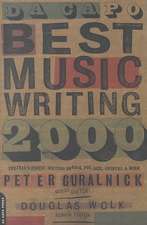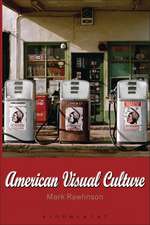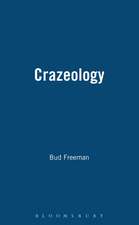James Brown's Live at the Apollo: 33 1/3
Autor Douglas Wolken Limba Engleză Paperback – 30 sep 2004
Din seria 33 1/3
- 39%
 Preț: 47.02 lei
Preț: 47.02 lei - 39%
 Preț: 46.92 lei
Preț: 46.92 lei - 40%
 Preț: 46.46 lei
Preț: 46.46 lei - 40%
 Preț: 46.65 lei
Preț: 46.65 lei - 39%
 Preț: 46.74 lei
Preț: 46.74 lei - 39%
 Preț: 47.09 lei
Preț: 47.09 lei - 40%
 Preț: 46.29 lei
Preț: 46.29 lei - 39%
 Preț: 46.74 lei
Preț: 46.74 lei - 39%
 Preț: 47.19 lei
Preț: 47.19 lei - 39%
 Preț: 46.74 lei
Preț: 46.74 lei - 39%
 Preț: 47.62 lei
Preț: 47.62 lei - 40%
 Preț: 46.39 lei
Preț: 46.39 lei - 39%
 Preț: 46.92 lei
Preț: 46.92 lei - 39%
 Preț: 46.74 lei
Preț: 46.74 lei - 40%
 Preț: 46.46 lei
Preț: 46.46 lei - 39%
 Preț: 46.84 lei
Preț: 46.84 lei - 40%
 Preț: 46.29 lei
Preț: 46.29 lei - 40%
 Preț: 46.56 lei
Preț: 46.56 lei - 40%
 Preț: 46.29 lei
Preț: 46.29 lei - 39%
 Preț: 46.92 lei
Preț: 46.92 lei - 39%
 Preț: 47.53 lei
Preț: 47.53 lei - 39%
 Preț: 46.74 lei
Preț: 46.74 lei - 39%
 Preț: 47.62 lei
Preț: 47.62 lei - 39%
 Preț: 46.92 lei
Preț: 46.92 lei - 39%
 Preț: 47.27 lei
Preț: 47.27 lei - 40%
 Preț: 46.39 lei
Preț: 46.39 lei - 40%
 Preț: 46.29 lei
Preț: 46.29 lei - 39%
 Preț: 46.74 lei
Preț: 46.74 lei - 39%
 Preț: 47.62 lei
Preț: 47.62 lei - 40%
 Preț: 46.02 lei
Preț: 46.02 lei - 39%
 Preț: 47.44 lei
Preț: 47.44 lei - 40%
 Preț: 46.39 lei
Preț: 46.39 lei - 39%
 Preț: 46.92 lei
Preț: 46.92 lei - 39%
 Preț: 47.09 lei
Preț: 47.09 lei - 39%
 Preț: 46.74 lei
Preț: 46.74 lei - 39%
 Preț: 47.19 lei
Preț: 47.19 lei - 39%
 Preț: 46.74 lei
Preț: 46.74 lei - 39%
 Preț: 46.74 lei
Preț: 46.74 lei - 39%
 Preț: 46.74 lei
Preț: 46.74 lei - 39%
 Preț: 46.74 lei
Preț: 46.74 lei - 39%
 Preț: 46.74 lei
Preț: 46.74 lei - 40%
 Preț: 46.65 lei
Preț: 46.65 lei - 39%
 Preț: 47.19 lei
Preț: 47.19 lei - 40%
 Preț: 46.29 lei
Preț: 46.29 lei - 39%
 Preț: 46.74 lei
Preț: 46.74 lei - 40%
 Preț: 46.56 lei
Preț: 46.56 lei - 40%
 Preț: 46.46 lei
Preț: 46.46 lei - 40%
 Preț: 46.56 lei
Preț: 46.56 lei - 39%
 Preț: 46.74 lei
Preț: 46.74 lei
Preț: 46.56 lei
Preț vechi: 77.07 lei
-40% Nou
Puncte Express: 70
Preț estimativ în valută:
8.91€ • 9.27$ • 7.46£
8.91€ • 9.27$ • 7.46£
Carte disponibilă
Livrare economică 22 februarie-08 martie
Livrare express 08-14 februarie pentru 45.73 lei
Preluare comenzi: 021 569.72.76
Specificații
ISBN-13: 9780826415721
ISBN-10: 0826415725
Pagini: 128
Dimensiuni: 134 x 164 x 9 mm
Greutate: 0.13 kg
Ediția:New.
Editura: Bloomsbury Publishing
Colecția Continuum
Seria 33 1/3
Locul publicării:New York, United States
ISBN-10: 0826415725
Pagini: 128
Dimensiuni: 134 x 164 x 9 mm
Greutate: 0.13 kg
Ediția:New.
Editura: Bloomsbury Publishing
Colecția Continuum
Seria 33 1/3
Locul publicării:New York, United States
Recenzii
...he advances, word by word, through the centerpiece of the disk, "Lost Someone," he tracks the cries emitted from the audience by a mysterious "little old lady," and then he speaks very well about the knees, the microphones, and the capes of James Brown the tragedian. Written in clear and precise language, the book is ideal while listening to the recording in, for example, the Deluxe edition brought out last year with notably improved sound.
...slim, elegant volume.
Wolk breaks down the show minute by minute, song by song, to get at what made it such a transformative event.
...exemplary analysis of James Brown's legendary LP...
The highlight is Douglas Wolk's examination of James Brown's Live at the Apollo, which reads like a hypertext book. He moves moment-by-moment through the recording of the album, stopping every few paragraphs to elaborate, explain or digress. In the process, he opens up not only the particulars of Brown's live shows at the time, but how the Apollo show fits into Brown's legendary career, how Brown and his material fit into the history of R&B, and how the album fits into American culture, being recorded on the eve of the Cuban Missle Crisis.
James Brown's Live at the Apollo is famed as the best concert recording of his raw showmanship. Taped in the fall of 1962 at the venerable, and even legendary, showcase for black performers, the Apollo Theater of Harlem, the recording captured Brown when he was still something of an underground phenomenon. With a series of hits on the R&B charts to his credit, he was poised to move in on the pop charts. The show recorded was Brown's twenty-fourth that week--testimony in itself that he was indeed, as his publicity claimed, "the hardest working man in show business." Wolk neatly assesses the record's context and its function as the fuel for Brown's ascent to the pop stratosphere.
The setup's a stretch--'Most of the audience thought they'd be dead within the week'--but Wolk makes the case that the then-brewing Cuban missile crisis had something to do with why this is the most explosive live album ever. Wolk's writing is so evocative and his observations on Brown as the artist who becomes the art are so keen that you'll have the CD blaring in the background before he goes into his meticulous cut-by-cut analysis. And you'll hear things you never noticed before. A
James Brown's Live at the Apollo has often been cited as the first live album to make the concept commercially viable. Author Wolk races through the record like Brown through a set, splitting his ideas into very small sections, often barely a paragraph long, and capturing the electricity of the recording. He links to aspects of Brown's wider career "one of the strangest is 'The Knees of James Brown'), but these breaks don't interrupt the flow.
Live recordings are something we often take for granted. We forget that what we're hearing is more than music. That it's an event, something that happened in a specific time, at a specific place. Douglas Wolk, through piecing together the events of the evening in 1962 where James Brown recorded his classic Live at the Apollo performance, brings the event, the place, the music to life. If you haven't heard Live at the Apollo, do so now--it's essential. Then read this book, which promotes an even deeper love for James Brown's landmark album.
This dissection of James Brown's Oct. 24, 1962, show at the Apollo and the resulting album is a resplendent work for both the amount of research and the passion Wolk provides. This short album history is not only a vivid recollection of Brown, but a colorful illustration of the time.
According to Pitchfork contributor Douglas Wolk's careful reconstruction of the making of Live at the Apollo, nuclear annihilation may have been averted by sheer force of Brown's will. Of course, the hardest-working man in show business had nothing to do with foreign relations, but Wolk shows how those fears of mass obliteration stoked Brown's showcase, pushing him to give even more to his crowd and prodding his audience to scream and shout as though their lives depended on it. Fortunately, humanity not only survived a nuclear standoff, but we got one of the greatest live albums ever.
...slim, elegant volume.
Wolk breaks down the show minute by minute, song by song, to get at what made it such a transformative event.
...exemplary analysis of James Brown's legendary LP...
The highlight is Douglas Wolk's examination of James Brown's Live at the Apollo, which reads like a hypertext book. He moves moment-by-moment through the recording of the album, stopping every few paragraphs to elaborate, explain or digress. In the process, he opens up not only the particulars of Brown's live shows at the time, but how the Apollo show fits into Brown's legendary career, how Brown and his material fit into the history of R&B, and how the album fits into American culture, being recorded on the eve of the Cuban Missle Crisis.
James Brown's Live at the Apollo is famed as the best concert recording of his raw showmanship. Taped in the fall of 1962 at the venerable, and even legendary, showcase for black performers, the Apollo Theater of Harlem, the recording captured Brown when he was still something of an underground phenomenon. With a series of hits on the R&B charts to his credit, he was poised to move in on the pop charts. The show recorded was Brown's twenty-fourth that week--testimony in itself that he was indeed, as his publicity claimed, "the hardest working man in show business." Wolk neatly assesses the record's context and its function as the fuel for Brown's ascent to the pop stratosphere.
The setup's a stretch--'Most of the audience thought they'd be dead within the week'--but Wolk makes the case that the then-brewing Cuban missile crisis had something to do with why this is the most explosive live album ever. Wolk's writing is so evocative and his observations on Brown as the artist who becomes the art are so keen that you'll have the CD blaring in the background before he goes into his meticulous cut-by-cut analysis. And you'll hear things you never noticed before. A
James Brown's Live at the Apollo has often been cited as the first live album to make the concept commercially viable. Author Wolk races through the record like Brown through a set, splitting his ideas into very small sections, often barely a paragraph long, and capturing the electricity of the recording. He links to aspects of Brown's wider career "one of the strangest is 'The Knees of James Brown'), but these breaks don't interrupt the flow.
Live recordings are something we often take for granted. We forget that what we're hearing is more than music. That it's an event, something that happened in a specific time, at a specific place. Douglas Wolk, through piecing together the events of the evening in 1962 where James Brown recorded his classic Live at the Apollo performance, brings the event, the place, the music to life. If you haven't heard Live at the Apollo, do so now--it's essential. Then read this book, which promotes an even deeper love for James Brown's landmark album.
This dissection of James Brown's Oct. 24, 1962, show at the Apollo and the resulting album is a resplendent work for both the amount of research and the passion Wolk provides. This short album history is not only a vivid recollection of Brown, but a colorful illustration of the time.
According to Pitchfork contributor Douglas Wolk's careful reconstruction of the making of Live at the Apollo, nuclear annihilation may have been averted by sheer force of Brown's will. Of course, the hardest-working man in show business had nothing to do with foreign relations, but Wolk shows how those fears of mass obliteration stoked Brown's showcase, pushing him to give even more to his crowd and prodding his audience to scream and shout as though their lives depended on it. Fortunately, humanity not only survived a nuclear standoff, but we got one of the greatest live albums ever.


















